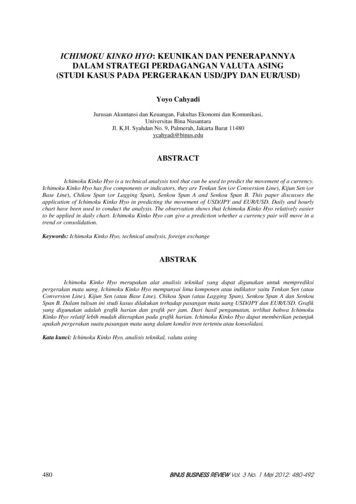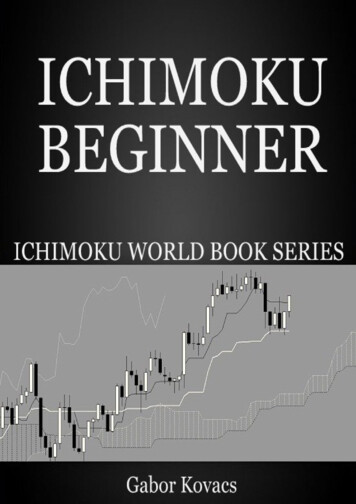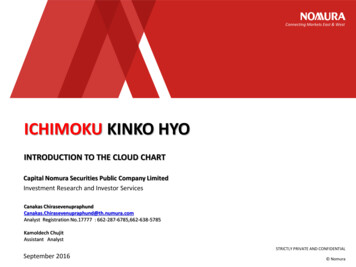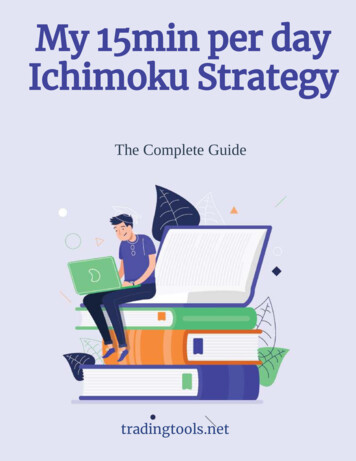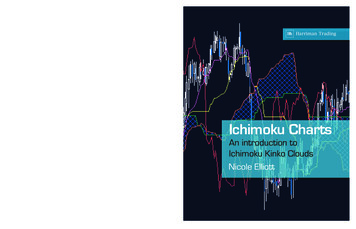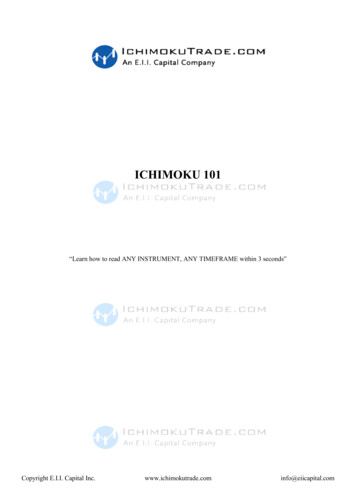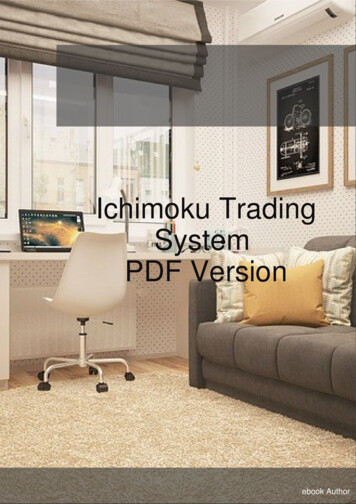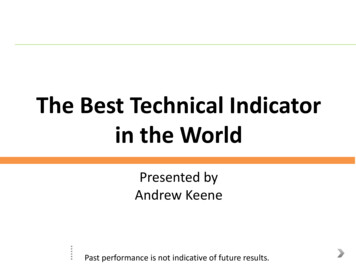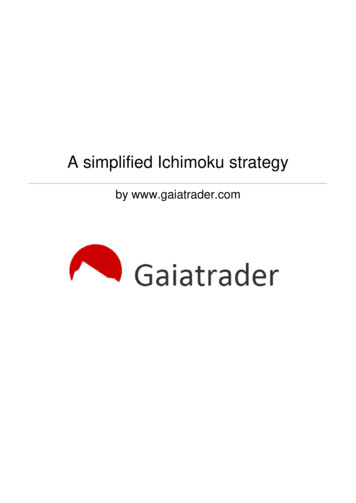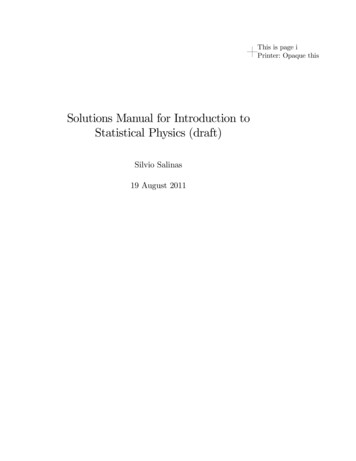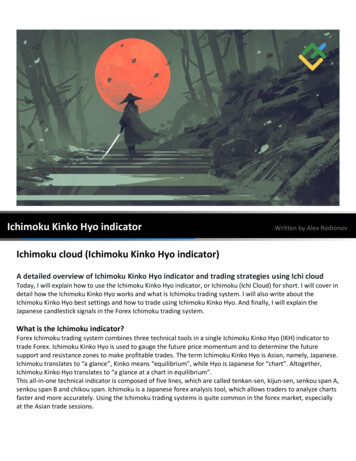
Transcription
Ichimoku Kinko Hyo indicatorWritten by Alex RodionovIchimoku cloud (Ichimoku Kinko Hyo indicator)A detailed overview of Ichimoku Kinko Hyo indicator and trading strategies using Ichi cloudToday, I will explain how to use the Ichimoku Kinko Hyo indicator, or Ichimoku (Ichi Cloud) for short. I will cover indetail how the Ichimoku Kinko Hyo works and what is Ichimoku trading system. I will also write about theIchimoku Kinko Hyo best settings and how to trade using Ichimoku Kinko Hyo. And finally, I will explain theJapanese candlestick signals in the Forex Ichimoku trading system.What is the Ichimoku indicator?Forex Ichimoku trading system combines three technical tools in a single Ichimoku Kinko Hyo (IKH) indicator totrade Forex. Ichimoku Kinko Hyo is used to gauge the future price momentum and to determine the futuresupport and resistance zones to make profitable trades. The term Ichimoku Kinko Hyo is Asian, namely, Japanese.Ichimoku translates to “a glance”, Kinko means “equilibrium”, while Hyo is Japanese for “chart”. Altogether,Ichimoku Kinko Hyo translates to “a glance at a chart in equilibrium”.This all-in-one technical indicator is composed of five lines, which are called tenkan-sen, kijun-sen, senkou span A,senkou span B and chikou span. Ichimoku is a Japanese forex analysis tool, which allows traders to analyze chartsfaster and more accurately. Using the Ichimoku trading systems is quite common in the forex market, especiallyat the Asian trade sessions.
1. History of Ichimoku Kinko Hyo indicatorThe Ichimoku Kinko Hyo, or Ichimoku for short, is a standard trend indicator included in the list of built-inindicators of the Meta Trader and other trading platforms.The Ichimoku technical indicator was developed by Goichi Hosoda, a Japanese journalist, in the late 1930s. Theanalyst published his article in the trading journals, he was used to be known as Ichimoku Sanjin.The technical analysis indicator was named after his pseudonym. The original aim was to predict the trend of theJapanese major stock index Nikkei. The primary task of the indicator is the identification of a trend that isrepresented as the signal line, and the secondary task is to show the support/resistance levels.Although Ichimoku developed the tool before World War Two, he released his findings to the general publicmuch later, in 1968. He spent 30 years perfecting the technique.2. Ichimoku's Graphic Environment: how to read Ichimoku cloud charts?The below screenshot displays how the indicator looks in the price chart with the default settings.Key elements of the indicator:Tenkan sen (the red line).It is the average value of the highest high and the lowest low for the first time period. Thedefault value 9.Kijun sen (the blue line). It is the average value of the highest high and the lowest low for the second time period.The default value is 26.Senkou Span A and Senkou Span B form the edges of the cloud. The A line averages the values of Tenkan and Kijun,it is plotted 26 periods ahead. The B line calculates the average of the highest high and the lowest low over thepast 52 time periods. It is also plotted 26 periods ahead.Chikou Span (the green line). It is the so-called lagging span. It calculates today's closing price projected back 26days on the chart.In addition to the base lines, there are some other prominent elements of the indicator, filled zones. They are theso-called clouds. The cloud is the area between the Senkou lines А and B.
If Senkou A is below Senkou B, the zone is purple, which signals a downtrend.If Senkou A is above Senkou B, the zone is orange and the trend is up.3. How to use Ichimoku Kinko Hyo Indicator?We have studied technical aspects of the lines’ calculation. Now, let us see what these lines are used for andwhat they mean.In general, the Ichimoku cloud is designed to spot direction and momentum in order to help you make buy andsell decisions more easily. You can have a brief look at the chart and see the trend direction and the price locationrelative to the support/resistance levels, and then, you can look for a corresponding pattern to enter a buy or selltrade.An important note. The tool was designed to analyze quite long timeframes, daily and weekly charts of the Nikkei.Later, this algorithm was applied to the forex chart analysis.Besides, financial are more volatile than 90 years ago. The indicator still quite accurately anticipates middle- andlong-term trends, but it can also be employed in shorter Forex trading timeframes, starting from H1.I do not recommend using timeframes shorter than one hour. Perfect timeframes to trade with the Ichimokucloud are H1-D1.You can trade any currency pairs.3.1. How to identify the trend using Ichimoku Cloud?The long-term trend is defined using the filled zones, Ichimoku clouds. If the price is trading below the cloud, thetrend is down. If the price ticker in the chart is trading above the cloud, the trend is up.The color of the cloud is also important. A purple cloud means that the price could fall soon. An orange cloudsignals that the price should start rising soon.A perfect case for entering buy trades is when the price is trading above the orange cloud.When the price is trading inside a cloud it means there is no clear trend.
The medium-term trend is defined by the Kijun line, and the short-term trend is indicated by the Tenkan line.These lines are basically common moving averages, but the calculation is different. They are the average of highand low over a particular time. There is an opinion among the speculators trading with the Ichimoku cloud thatthe Tenkan and Kijun lines are more accurate than common EMAs.You should also assess the direction of these lines and the angle. The more acute is the angle, the stronger is thetrend.When Tenkan and Kijun are horizontal, there is the accumulation zone in the market.As the Ichimoku technical tool is a leading indicator, it can be used to anticipate the market situation in the mediumterm and long-term outlook. The clouds projected into the future give clues on possible movements of the trend.The below screenshots present the examples of such projections:
3.2. The role of dynamic levels of Ichimoku Kinko HyoAll Ichimoku lines, except the Chikou span, may serve as important levels. It is suggested that the Tenkan line israther weak, while the Kijun line is a much more important level.Senkou A and Senkou B are key levels, which are the strongest. The cloud itself is also a level.Let us see how it works on an example:
3.3. Flat zones - Ichi cloudsFlat zones are Ichimoku clouds, within which you can also trade. As you know, when an instrument is trading flat,one should enter trades at the borders of the trading range. If the price goes into the filled zone, the Senkou Aand Senkou B become reference levels, where one could enter trades with targets at the opposite level.The above figure displays the GBPUSD H1 chart. You can see that, on April 23, 2022, the price broke through theSenkou A line and entered the cloud.
Next, via the retest of the broken-out Senkou A, the price reached Senkou B and even went beyond the cloudzone. At the next bar, however, the price rolled back to the trading range, drawing a false breakout pattern. Thefalse breakout of the Senkou B was a signal to enter a sell trade with the target at the opposing strong level.Note that the price has twice tested the Senkou A line from above after it broke the line out. A buy pattern wasformed at the Asian session and, later, at the European session. At the U.S. session, the market sent a signal tosell the GBPUSD.3.4. The role of the Chikou span oscillatorBasically, the Chikou line is a momentum indicator. Like any oscillator, it is designed to indicate the pricedeviation from the average value. Significant deviations create the overbought/oversold zones, which indicates apotential correction or a trend reversal.4. Parameters and values: Ichimoku Kinko Hyo best settingsLet us enter the indicator parameters. We see three variables:1. Tenkan period (default value 9)2. Kijun period (default value 26)3. Senkou Span B period ( default value 52)The default settings of the Ichimoku cloud are quite effective, so, I do not recommend beginners to change them.When you study the working principle of the Ichimoku tool, you can experiment with its parameters.Originally, Goichi Hosoda, when developing the indicator, referred to the Japanese stock market and Japaneseworking days, which were six days a week at that time. So, he took a period of 1.5 weeks for the Tenkan line. 26period originally meant working days in a month, and 52 is the number of weeks in a year. You can set the indicator parameters according to the current conditions:Tenkan 5Kijun 20Senkou Span B 52As a result, you will have the data changing more dynamically, but this is not always better. Anyway, you shouldtest the changed parameters and compare them with the default values. Only after that, you can decide.5. How to read Ichimoku cloud charts and how to trade using Ichimoku Kinko Hyo?5.1. Patterns of Tenkan and Kijun lines
Traders usually consider signals created by the Tenkan and Kijun lines in two cases:When the lines cross;When the lines are facing in the same direction.Ichimoku Tenkan and Kijun are crossingWhen the Tenkan line crosses the Kijun upside, there is a Golden Cross pattern. This is a buy pattern.When the Tenkan line crosses the Kijun downside, there is a Dead Cross pattern. This a sell pattern.Based on the market situation, the above patterns may signal the trend continuation or correction. They shouldbe taken into account, but they are not the strongest signals, so, I recommend trading according to the patternsthat are consistent with the general trend. To trade in the correction, i.e. counter the trend, there shouldadditional confirming signals.How to trade the Tenkan and Kijun crossing?You can enter a trade once the signal bar closes. A stop loss is set beyond the next local high or low. Anotheroption is to enter a trade at the breakthrough of the local high or low in the direction suggested by the signal (i.e.if it is a buy pattern, you enter when the price breaks through the local high).There is no universal entry rule. You should make a decision according to the particular market situation and yourpersonal trading style.
Kijun and Tenkan alignment patternKijun and Tenkan's alignment in the same direction means that the local and middle-term trends are the same,which suggests entering a trade. You should also analyze the long-term trend when you want to enter a tradebased on the alignment of the Ichimoku Kijun and Tenkan lines. The long-term trend must confirm the idea to buyor sell a trading instrument.You can enter a trade immediately after a trending movement starts when the lines have located in the samedirection. You can also enter a trade in the middle of the trend, but, in this case, you’d better expect a correctionor the test of the red or the blue line or the zone that is created between these lines.
5.2. Senkou Span signals (A and B)Signals sent by the Senkou Span lines and the cloud they create. The Senkou span A and B lines could be thesupport or resistance levels, depending on the trend. The Senkou Span A is a less important level, the SenkouSpan B is thought to be stronger, it marks the border of the long-term trend.The cloud’s color changes when the faster Senkou Span A crosses the slower Senkou Span B, and so, there areearly signals of the trend reversal. Therefore, entering a trade after these lines cross will be at the inceptive stageof a new trend. Here is the example of trading signals occurred when the cloud’s color changes:I recommend entering a trade after the Ichimoku cloud has changed the color. A Stop Loss, in a perfect situation,is put at some distance from the cloud. Note that the new cloud forms 26 periods ahead, so pay attention to themoment when the signal to buy or sell the pound was formed in the above screenshot.5.3 The signal when the price breaks out the Senkou Span B.There is another signal, a leading one, when the price breaks out the Senkou Span B. The line itself is a dynamiclevel and marks the trend border. Therefore, if the outer border is not broken, the trend is likely to continue. Ifthe price breaks through the filled zone, the trend should reverse soon.Let us study the examples of the rebound and the breakout of the Senkou Span B line. I recommend you to payattention to the breakouts and the price further movement:
5.4. Trading within Ichimoku cloudWhen the price is trading within the filled are, the cloud, it means there is forming an accumulation zone or flat.When the price is trading flat, one should enter trades at the borders of the range, and this trading strategy is notas simple as trading with the trend.To have a more or less wide trading range, you need to expect cloud expansion. It is not always relevant to entertrades when the price is within the Ichimoku cloud.Trading in the range suggests entering trades in the direction of the Senkou Span B when the price breaks out theSenkou Span A. When the price reaches Senkou Span B you should be trading in the direction of the first line andso on.I do not recommend one to use limit orders or enter a trade immediately after the price breaks out the SenkouSpan A. First, the breakout could be false. Second, the range within the cloud usually doesn’t allow entering onthe breakout with an acceptable Reward/Risk ratio (2/1 or more).Tenkan and Kijun in the Ichimoku cloud are still strong levels. It is safer to enter trades at the levels around theselines.
The above screenshot displays two different cases. In the left figure, the price was trading between Span A andSpan B. In the right one, the Tenkan and Kijun were also used as strong levels.Trading in the Ichimoku cloud is employed by professional traders who know what they do. To detail the entrypoint, they use shorter timeframes and the Japanese candlestick patterns. I do not recommend newbies to tradein the cloud, as this trading strategy is quite difficult. Beginner traders should first master trading according tosimpler and stronger signals described above.5.5. Chikou SpanAs I wrote earlier, the Chikou Span serves as an oscillator in the Ichimoku trading system. Therefore, the firstthing you should pay attention to is how the price has deviated from the green line. A wide gap between theoscillator and the current price means there should soon start a correction opposite to the main trend.If you witness such a situation and the Japanese candlesticks generate an additional pattern to buy or sell counterthe major trend, you can use this important signal and trade in the direction of the correction.Another important signal appears when the Chikou Span crosses the price chart. When the Chikou Span linecrosses the price chart from below, this is a buy signal. If the Ichimoku Chikou comes from above, this is a sellsignal.You should remember that the oscillator is projected back 26 bars. Approximately as many days, according to theIchimoku tool developer, large traders need to accumulate the position before the further strong move.
As you see from the above example, the bar on the right of the vertical line signals the Chikou Span breakoutupside or downside 26 bars ago. The rectangle highlights the price range where this pattern has formed as ofnow. The arrows mark the further price move in the pattern direction. This pattern rarely occurs, but it provides astrong signal in the Ichimoku system.5.6. All the lines are arranged in the same directionWhen all the indicator’s lines are facing in the same direction, there is a strong pattern that suggests entering atrade in the trend direction.You see from the examples that the Ichimoku cloud, the Tenkan, and Kijun are facing in the same direction, whichis the only possible way to enter a trade.
6. Japanese candlesticks in the Forex Ichimoku trading systemIchimoku Sanjin stressed the importance of using the Japanese candlestick analysis when trading the Ichimokusignals. Without analyzing the patterns generated by the Japanese candlesticks, the probability that the trade willbe successful is about 60%-70%. However, if professional trades apply the analysis of Japanese candlesticks as anadditional filter, they can reach an 80% chance of success or even more.Here, the Ichimoku trading strategy becomes more complicated, and you will have to miss some signals.However, if you practice the candlestick analysis, you will achieve better results as you will cut the potential stoploss size, detail the entry point more accurately and exit the trades on time.I recommend you to confirm your trading ideas to buy or sell employing the signals delivered by simplecandlestick patterns. You can also employ Price Action patterns. You do not have to learn and trade all thepatterns.Three or five most common price patterns will be enough, provided you use them often. After all, an indicator isjust a derivative of the price movements, and the price chart is always primary. Only the price movementsindicate the real market situation.I covered in detail the most important price action patterns in the previous educational article, Price Action Forexstrategies.7. Conclusion and a trader opinion of Ichimoku Kinko HyoThe Ichimoku Kinko Hyo indicator is the most complicated tool among standard momentum indicators included inmost trading platforms. This is a free indicator, which is an advantage.Although the Ichimoku signals seem complicated to read, any trader can understand the Ichimoku indicator.Of course, I recommend all traders to study and use in practice this powerful technical tool. Basically, it is acomplete trading strategy suitable for all investors. It considers trading with the trend, flat, and trading in thecorrection.If you are a newbie, I recommend you to start studying the Ichimoku indicator and strategies trading with a longterm trend. When you go through this stage and gain more trading experience, you can employ other patterns aswell.Do not forget to confirm your trading ideas to buy or sell with candlestick patterns. This will allow you to be moreconfident when making trading decisions and get a better Reward/Risk ratio. I think using a Price Action Forexstrategy when you considering entries at the key levels will help you increase the final profit.It can take you quite a long time to master the Ichimoku trading system, but it is obviously worth studying, as thechance of a win is about 80% when you learn to employ all the capacities of the Ichimoku indicator.Ichimoku indicator is available in the MT4 platform for free and is one of the built-in indicators in it. I recommendusing LiteForex online platform in the beginning of your journey as a trader - there the Ichimoku indicator is alsoone of the built-in ones.You could also read the review of my colleague here to learn the behavior of Ichimoku indicator on thecryptocurrency market.
FAQsHow to read Ichimoku cloud charts?Ichimoku chart is made of three lines and the cloud. Usually, the cloud is formed by an upper and lower level,making it a total of five lines in the chart. Each of these lines function in a way that they take into considerationpast data from a specified time period. The functional lines in the Ichimoku indicator are:KIJUN SEN (BLUE LINE) - this is known as the standard or base line. It is calculated by averaging the highest highand the lowest low in a specified time range of past 26 timeframe.TANKAN SEN (RED LINE) - this line, also known as the turning line, functions by taking into consideration, thehighest and the lowest points on the chart for a timeframe of past 9 periods.CHIKOU SPAN (GREEN LINE) - this is the lagging line of the chart. It is the day’s closing price plotted behind by 26periods. It mimics the price action of the commodity.SENKOU SPAN (ORANGE LINE) this line is calculating with the help of two other lines; the Tenkan Sen and KijunSen. These lies are averaged to derive the Senkou Sen, and is plotted 26 periods ahead. There is also a secondsenkou line which is determined by averaging the support and resistance levels for the past 52 periods andplotted on 26 periods ahead.These lines featured in the Ichimoku Kinko Hyo and they are really important in the reading and interpretation ofthe chart.How to trade using Ichimoku Kinko Hyo?According to the location of the lines, you can determine the trend’s strength and direction. The trend is down ifthe Tenkan-sen and the Kijun-sen are above the price (the faster line, the Tenkan-sen, is closer to the price).And vice versa, if the lines are below the price (the Tenkan-sen is closer to the price). There is a steady uptrend.If the fast Tenkan-sen crosses below the slow Kijun-sen, and the lines are crossing above the price (the price isbelow the lines), it may signal the price should soon turn down.And vice versa, If the fast Tenkan-sen crosses above the slow Kijun-sen, and the lines are crossing below the price(the price is above the lines), it may signal the price should soon turn up.These crossover trade signals may be lagging, so traders are not advised to rely exclusively on the Ichimokuindicator and its elements.
Useful links:I recommend trying to trade with a reliable broker here. The system allows you to trade by yourself or copysuccessful traders from all across the globe.Telegram channel with high-quality analytics, Forex reviews, training articles, and other useful things for tradershttps://t.me/liteforexThe content of this article reflects the author’s opinion and does not necessarily reflect the official position ofLiteForex. The material published on this page is provided for informational purposes only and should not beconsidered as the provision of investment advice for the purposes of Directive --------------Follow us on
The Ichimoku Kinko Hyo, or Ichimoku for short, is a standard trend indicator included in the list of built-in indicators of the Meta Trader and other trading platforms. The Ichimoku technical indicator was developed by
